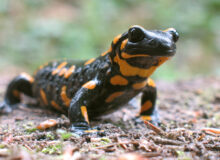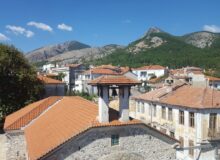The Mani
The Mani in the south of the Peloponnese is the most southerly part of the Greek mainland and famous for its rugged landscape, historic feuds and tower houses.

Of the three peninsulas that jut southward on the Peloponnese, the central ‘finger’ is the Mani. Its tip at Cape Matapan (Akra Tenaro) is the southernmost point of the Greek mainland, and the legendary entrance to Hades (Hell). Even without such associations, you know that when you enter the Mani you are entering a very special part of Greece.
The landscape becomes much more barren and rugged in the south of the region, known as the Lower Mani, where you will start to see the distinctive stone tower houses that hint at the violence that existed here in the past.

History of The Mani
The remoteness of the Mani meant that it was always a place of escape or refuge, and the families who settled here in the 15th century became very clan-like, fighting bitterly for the best areas of land. The Nyklian family were dominant and at first they alone had the right to build onto their properties the characteristic tall, square, stone towers, which were used for both defence and attack. The taller the tower, the easier it was to fire down on enemies through the narrow slits of windows.
Tower Houses of the Mani

Eventually other families began to build towers, each trying to build as high as possible. If one family offended another, or killed someone, then a feud began, heralded by the ringing of church bells and a retreat by the respective families into their towers. Such feuds often lasted for years and down generations, as the sense of honour was great. There was no difficulty in keeping the tower houses supplied as women were protected and could continue to bring food and drink into the towers for the men.
The only hiatus in the feuding came at harvest time when a truce was called. A feud could only be ended by total annihilation or capitulation by one party. The last recorded feud of this kind took place in 1870 in Kita, and was stopped only by the intervention of the Greek army.
Where to See the Tower Houses
Kita is one place where the tower houses survive, and there are also several clustered dramatically in the village of Vatheia, in the far south of the Mani, but you will see others as you travel around, sometimes just a single tower in an isolated village.
Travel Writers in The Mani

There is much more to the Mani, though, than feuds and a barren landscape. Several delightful fishing villages welcome visitors in summer, such as Stoupa and Kardamyli. In a grave just outside Kardamyli is the grave of the British travel writer and novelist Bruce Chatwin (1940-1989) who loved the area. He was inspired by one of his heroes, another British travel writer, Patrick Leigh Fermor. Fermor lived in Kardamyli for many years and his house still stands. His travel book, Mani, is essential reading if you plan to travel in the region
Around the Mani

The northern region, known as the Outer Mani, is dominated by the mountain range of Taygetos, a defiant spine of rock climbing to a height of 7,885 ft (2,404 m). The lower slopes offer wonderful walking opportunities, as well as a scenic backdrop of pine forests, but seek the advice of local guides if you plan to do anything more adventurous.
The main town of the Inner Mani, the southern part of the peninsula, is Areopoli. This town provides all the facilities you might want, including a few hotels, but it is not the best place to be based for any length of time. On the coast a few miles south of Areopolis is one of the region’s main attractions, the Spilia Dirou, or Diros Caves.
You can combine a 30-minute boat ride into the underground cave network with a short exploration on foot of the Alepotripa Caves. Both have dramatic stalactites and stalagmites. Those in the Diros Caves are enhanced by the echoey, damp atmosphere and striking reflections in the water.
Githio

The main town on the east coast of the Mani is Githio, which is also the capital of the whole area but very different in style from the rest of the Mani. It’s a busy and prosperous little port, with several good restaurants around its attractive harbour. With the remains of a Roman theatre, beaches on its outskirts, and a wide choice of accommodation, it’s a good place to be based and to relax while you make forays into the rest of the Mani.




















